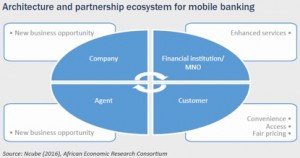Mthuli Ncube: Model Future for Mobile Banking
2017-04-21 IMI Regulatory implications
Under a functional approach to regulation of mobile banking, central banks have to maximise financial inclusion as well as focus on price stability, the growth of the network and payment system stability.
The regulator should adopt a risk-based approach to supporting financial inclusion. This is based on the risk that an activity poses to the individual participant and to the stability of the financial system. Equally, the regulator must find a balance between initial regulation, which defines the rules of the game, and intervention in response to the evolution of markets.
Regulators such as central banks and governments need to ensure that the environment is competitive and that monopolies are curtailed. Easy entry to and exit from the market should be encouraged. It is also important to develop the capacity for phone users of one telecommunication network to make calls and communicate with those of another.
Such interoperability is equally necessary in mobile banking, to ensure that users of one financial service’s digital network can transact with those on another. This deepens the penetration of mobile money, lowers the cost of transactions, broadens customer choice, and encourages competition.
The GSM Association, the body that represents mobile operators worldwide, has been promoting interoperability across Africa and the Middle East. In April 2014, the association announced that nine mobile network operators in the two regions were to work together to accelerate the implementation of cross-network mobile money services. These operators have 582m mobile connections across 48 countries in Africa and the Middle East.
Africa’s first interoperability arrangement was announced in June 2014 when the telecommunications company Tigo, which has 6.2m customers in Tanzania and 3.4m users of its Tigo Pesa system, said it would be linking with rivals Airtel and Zantel. Interoperability was extended further last year when Vodacom, Tanzania’s fourth mobile money provider, connected with Airtel and Zantel. This allows over 16m people to send money by mobile to each other in Tanzania, regardless of network. By contrast, in Uganda users of mobile money services are forced to use multiple mobile providers as the country has no interoperability.
Equal access to infrastructure
The final aspect of regulation, and one that is critical to the success of mobile banking services, is that there should be equal access to infrastructure. This refers to the right of providers to access on identical terms the infrastructure that underpins their services.
For mobile network operators, such infrastructure includes telecommunications lines, fibre optic networks, the power grid, and water supply. For providers of digital financial services, the required infrastructure includes the telecommunication system, and network services for payment and settlement credit bureaux.
Both providers and regulators have important roles to play in breaking down barriers to expansion. That is the crucial condition for ensuring mobile networks continue to transform banking in emerging markets.
Regulatory implications
Under a functional approach to regulation of mobile banking, central banks have to maximise financial inclusion as well as focus on price stability, the growth of the network and payment system stability.
The regulator should adopt a risk-based approach to supporting financial inclusion. This is based on the risk that an activity poses to the individual participant and to the stability of the financial system. Equally, the regulator must find a balance between initial regulation, which defines the rules of the game, and intervention in response to the evolution of markets.
Regulators such as central banks and governments need to ensure that the environment is competitive and that monopolies are curtailed. Easy entry to and exit from the market should be encouraged. It is also important to develop the capacity for phone users of one telecommunication network to make calls and communicate with those of another.
Such interoperability is equally necessary in mobile banking, to ensure that users of one financial service’s digital network can transact with those on another. This deepens the penetration of mobile money, lowers the cost of transactions, broadens customer choice, and encourages competition.
The GSM Association, the body that represents mobile operators worldwide, has been promoting interoperability across Africa and the Middle East. In April 2014, the association announced that nine mobile network operators in the two regions were to work together to accelerate the implementation of cross-network mobile money services. These operators have 582m mobile connections across 48 countries in Africa and the Middle East.
Africa’s first interoperability arrangement was announced in June 2014 when the telecommunications company Tigo, which has 6.2m customers in Tanzania and 3.4m users of its Tigo Pesa system, said it would be linking with rivals Airtel and Zantel. Interoperability was extended further last year when Vodacom, Tanzania’s fourth mobile money provider, connected with Airtel and Zantel. This allows over 16m people to send money by mobile to each other in Tanzania, regardless of network. By contrast, in Uganda users of mobile money services are forced to use multiple mobile providers as the country has no interoperability.
Equal access to infrastructure
The final aspect of regulation, and one that is critical to the success of mobile banking services, is that there should be equal access to infrastructure. This refers to the right of providers to access on identical terms the infrastructure that underpins their services.
For mobile network operators, such infrastructure includes telecommunications lines, fibre optic networks, the power grid, and water supply. For providers of digital financial services, the required infrastructure includes the telecommunication system, and network services for payment and settlement credit bureaux.
Both providers and regulators have important roles to play in breaking down barriers to expansion. That is the crucial condition for ensuring mobile networks continue to transform banking in emerging markets.
